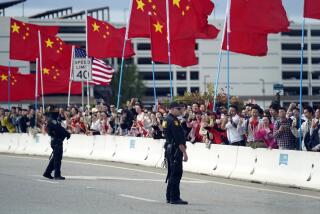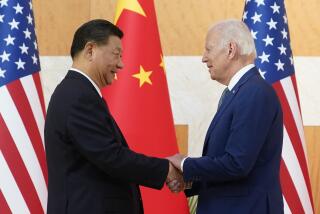Asian Foot-Draggers Jeopardize U.S. Growth
WASHINGTON — There is growing tension and frustration beneath the cordial surface of the annual meetings of the Asia Pacific Economic Cooperation forum (APEC). The ambitious APEC program of reducing trade barriers, conceived during the Bush administration and launched with much fanfare in Seattle in 1993 by the Clinton administration, is floundering, thanks to Asian foot-dragging and U.S. inattention.
Tomorrow, when he meets with the heads of state of APEC nations, President Bill Clinton should lay down a challenge to America’s Asian trading partners. If the pace of regional trade liberalization does not accelerate by next year’s gathering in Vancouver, the United States will begin free-trade discussions with individual Asian nations, such as Singapore, that share Washington’s goal of open markets. Short of such a bold initiative, U.S. exports are likely to flag, trade tensions between the United States and much of Asia will intensify and APEC risks becoming irrelevant.
At the APEC gathering in Bogor, Indonesia, in 1994, members agreed to “achieve free and open trade and investment in the region” by 2010 for industrial nations, by 2020 for remaining nations. At tomorrow’s meeting in Subic, the Philippines, member countries are expected to submit plans detailing how they intend to achieve these goals. Trade liberalization itself is supposed to begin in January 1997.
Compliance with this timetable is of vital importance to the United States, because the U.S. economy has become increasingly dependent on exports. U.S. exporters need easier access to Asia, the world’s fastest-growing marketplace, if their sales are to grow.
In recent years, exports have accounted for at least one-third of U.S. economic growth. Overseas sales have stimulated nearly a quarter of the growth in private-industry employment. At a time when average U.S. wages were stagnating, workers in the export sector earned up to 15% more than their counterparts supplying the domestic market.
If exports are to continue their role as a generator of economic growth, the United States must maintain and expand sales to Asia, where imports are growing by tens of billions of dollars a year. But the U.S. share of the region’s imports has been declining, falling from 16.5% of total East Asian imports in 1990 to 14.9% in 1995. More important, the U.S. share of East Asian imports of high technology--sales that generate the best-paying jobs in the United States--is also shrinking. Simply halting this erosion of market share will require a doubling of U.S. exports to the region over the next decade.
The APEC nations are not making it any easier. Several Asian governments have been reluctant to go along with the current U.S.-European-Japanese effort to eliminate all tariffs on computer chips, computers and other information technologies. Korea still effectively limits auto imports to less than 1% of its market. Southeast Asian governments have stymied U.S.-led efforts to lower barriers to trade and investment in financial and telecommunications services.
The United States would be foolish to continue to countenance such obstacles to U.S. exports and investment, because the window of opportunity for American businesses to get a foothold in Asia is closing. Following the Japanese model, China, Korea, Indonesia and Malaysia are busily building world-class auto and electronics industries behind protectionist walls. After a decade or two of such nurturing, these future Toyotas and Sonys could be formidable competitors, both at home and abroad.
In the past, Singapore, Korea and Taiwan have all expressed interest in individual free-trade arrangements, apart from APEC, with the United States. Now is the time to take them up on their offers.
To underscore the seriousness of his intent, the president should also announce at Subic that, early next year, he will seek trade negotiating authority from Congress to enable U.S. officials to immediately pursue closer trade ties. In the wake of the bitter fight over freer trade with Mexico, this request will encounter opposition on Capitol Hill. But without such negotiating authority, the United States will have little leverage to encourage APEC countries to lower their trade barriers.
In the end, the Clinton administration’s goal should not be to fracture APEC, but to create incentives among its members to liberalize their economies. If several Asian governments want to use APEC to delay trade liberalization, the United States needs to pursue its economic self-interest through other means. The widening trade deficit with Asia, especially with China, should be reason enough to act. Too much is at stake to passively accept their foot-dragging any longer.










